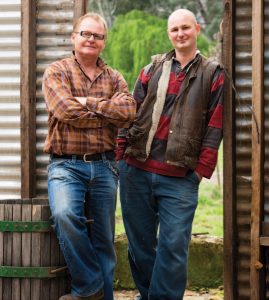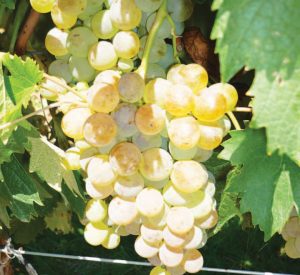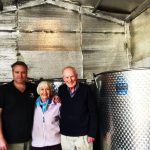By Joel Pizzini, Pizzini Wines, King Valley, Victoria
First published in the May/June 2013 issue of the Wine & Viticulture Journal
Specialising in the production of both French and Italian wine varieties, family-owned Pizzini Wines decided to take the plunge and grow Verduzzo in the mid-1990s to complement the existing Italian varieties it was already growing in Nebbiolo and Sangiovese.

Verduzzo is a crazy white variety that is considered to be the ‘red drinker’s white’. It is traditionally grown in Friuli-Venezia Giulia, in northern Italy. It is not the most important variety of the region, but Verduzzo can create some wonderful styles with great mouthfilling texture, complexity and long ageing capabilities.
The variety typically makes two distinct styles, dry and sweet. Ramandolo is the synonym for the sweeter versions, which are generally picked late. Bunches are partially dried prior to processing to retain the sweetness and the minimum allowable alcohol. A diverse range of foods can be served with Verduzzo.
In 1994 we grafted over a few vines in short rows with Verduzzo at the end of one of our vineyards. This was initially used to develop more buds to then graft to a larger vineyard and to experiment with winemaking.
We had little knowledge of growing Verduzzo when we took the plunge to produce it, but we had great faith in the King Valley’s diverse climate and soils and its ability to produce a wide range of varieties and wine styles. It is the cool nature of the King Valley coupled with dogged determination that we hoped would help the variety prosper.

As we already had Nebbiolo and Sangiovese developing, we were looking for a different Italian white variety to complement the range. At the time, there was not the access to the bud material compared with other alternative varieties in Australia. We had come across Verduzzo in the Yarra Valley at the Bianchet family winery, and remember that their version was a great style of the variety and aged extremely well.
For the first few years we produced Verduzzo, it was just enough to make about 80 litres of wine to explore the potential and the styles it could make. The first feature we found was its amazing tannin structure, especially once fermentation was halfway through; the tannins are very astringent and quite reminiscent of light red varieties. It wasn’t until 2001 that Pizzini Wines released its first commercial Verduzzo.
Viticulture
We eventually produced enough buds to graft an area of about 1ha of vines. The original vines were Sauvignon Blanc on Schwarzmann rootstock. The vines are planted on the river flats of the watershed of the King River, where the soil is a sandy clay loam. The vines are planted 2m apart and the row spacing is 3m.
The vines were trained on a double cordon and spur pruned to two-bud spurs and the foliage trained in a VSP fashion, with about 25% of canes allowed to hang down to allow airflow and sunlight to pass through the canopy. After veraison we passed through the vineyard and removed some of the excess shoots from around the clusters and the crown, mainly to improve sunlight penetration through the canopy and to aid hand-harvesting.
For the past few years we have observed that by training the vines this way, they produce a lot of water shoots and the yields were inconsistent and showing a slight biannual production. To control this tendency, last season we top-worked the vines to lay down new canes. The vines were retrained to an arched cane trellis system with 100% vertical shoot positioning.
Verduzzo has good botrytis resistance, but trellising in this way helped to space the fruit and allowed the clusters to hang freely. Airflow through the canopy was also improved and, as the size of the canopy was reduced, it made hand-picking much easier and quicker because the colour of the grapes are similar to the leaf colour.
Winemaking
Budburst for Verduzzo is generally in the first week of October and harvest is generally in the first or second week of March. In the first two years of production we harvested by machine, mainly because of the ease and staffing. We soon changed once we saw the effect on the resulting wine. The variety has a strong tannin level and the extra extraction from the mechanical harvesting resulted in very mouthfilling, dry tannins that then needed to be balanced with heavy fining and sweetening prior to bottling. Now we only handpick.
When deciding to harvest we are mainly looking for maturity in the tannin profile, freshly cut pear notes with crunchy texture and 11.8-12.5 Baume.
The Verduzzo grapes are then picked into slotted picking bins and transported to King Valley Wines (a contract winemaking facility) to go into the coolroom where the wine is then made. The grapes stay in the coolroom for 24-48 hours at 5oC. This cools the fruit to aid the reduction of the astringency and extraction of the tannins. The grapes are pressed to receive a free run cut at 550L/t. The pressings are rarely used and are generally blended to make a dry white wine.
There is no sulfur or enzyme added during the processing of the Verduzzo grapes or juice. Once the juice is pressed, a portion of the juice is transferred to barrels for wild ferment. The balance is racked after 12 hours and then warmed for fermentation. Initially the juice is seeded with the yeast Lallemand CY3079, as this yeast is not a reliable fermenter but gives great mouthfeel, richness and texture. We reseed four to five days later with EC1118 to aid the completion of fermentation.
Once the fermentation is dry, sulfur is added and the wine lees stirred weekly for the first two months before being slowly reduced as we see the palate developing and softening. The barrel portion is also stirred and allowed to partially go through malolactic fermentation; this is used for the edge of complexity it gives to the wine. The stirring of the lees has become an important technique in naturally softening the palate and giving the wine more roundness and complexity while maintaining varietal character. The barrel portion contributes to about 7-10% of the blend and seems to be the last piece of the puzzle. It finishes off the palate, giving the wine length and complexity and taming the tannin structure. Bottling is generally scheduled for September or October, depending on how the wine is maturing and developing. The wine is then aged in bottle for three to four months prior to release. However, those who wait and age their Verduzzo are greatly rewarded. It has the capability to age in a way very similar to Riesling, developing a golden colour with lovely honeyed characters, soft, generous mouthfeel and round textured tannins.
Over the years we have also experimented with a late harvest style. We have only produced this style in two vintages. We kept the fruit on the vines until they reached 14 Baume, then processed the grapes and stopped the fermentation with about 65g/L of residual sugar and an alcohol of 11%v/v. Although 2008 was the last time we made the sweet version, it is still developing and changing into a lovely, unique, late-harvest wine.
Verduzzo is a great food wine. It cries out for foods like prosciutto-wrapped figs, or pears with warm blue cheese. It has the texture and creamy richness to go with the likes of veal scaloppini and lightly roasted quail. Its robust and slightly spicy nature gives it the power to be matched even with mild curries. The sweet version loves toffee crème brûlée with roasted hazelnuts.
Verduzzo is an exciting white Italian variety and has plenty of opportunity to be developed in cool regions and regions that need varieties that have natural disease resistance. It’s an exciting variety to make, where the winemaker really needs to think and manage the techniques required to create the variety with complexity and stimulation.
Verduzzo Friulano

By Peter Dry, Emeritus Fellow, The Australian Wine Research Institute
Background
In Australia, this variety is known simply as Verduzzo (ver-DOOTZ-oh) but it is more correctly known as Verduzzo Friulano because there is more than one Verduzzo in Italy. For example, Verduzzo Trevigiano is a distinctly different variety. Synonyms of Verduzzo Friulano include Ramandolo, Ramandolo Dorato, Verdùz and Verdùç (Slovenia). It is an old variety, mainly grown in Friuli in north east Italy, particularly in the eastern province of Udine. It is also found in the Veneto. Verduzzo Friulano has been in decline in recent decades. Globally there were 812 ha in 2010 (down 50% from 2000), close to 100% in Italy. In Australia there are currently at least 7 producers of ‘Verduzzo’ wine, mainly in cool regions in Vic. and NSW.
Viticulture
Budburst is mid-season, and maturity is mid-season to late. Growth habit is semi-erect and vigour is moderate. Bunches are small to medium, winged, well-filled with tough-skinned medium berries that are green-yellow or gold depending on exposure. Flesh is juicy and slightly aromatic. Yield is regular and moderate. In Italy it is said to require cane pruning, to be tolerant of cold and well adapted to different environments so long as the soil is neither too fertile nor moist. In high potential sites, good canopy control and bunch thinning may be required to achieve adequate ripening. Verduzzo Friulano has low to moderate susceptibility to powdery and downy mildews and is tolerant of botrytis bunch rot due to its thick tough skin. Seven clones are available in Italy with variation in intensity of honey and floral characters in wine.
Wine
In Friuli, Verduzzo Friulano is used for varietal wines, both dry and sweet and occasionally sparkling, in at least eight DOCs including Lison-Pramaggiore and Colli Orientali di Friuli. In DOCG Ramandola the wines are mainly sweet, from vineyards in the hills above Nimis at 380 m elevation. The lesser-quality Verduzzo Trevigiano ripens later and may be blended with Verduzzo Friulano in some DOCs. Dry wines range from fresh and fruity with citrus character to full bodied, fruity and honey-like. Sweet wines from late harvested or semi-dried fruit may be the best wines: they have slightly astringent tannins and are lightly herbal with more honey character with age. In dry wines this astringency may be too pronounced. In Australia, dry wines have been described as light, refreshing, textural, fruity and floral.
















